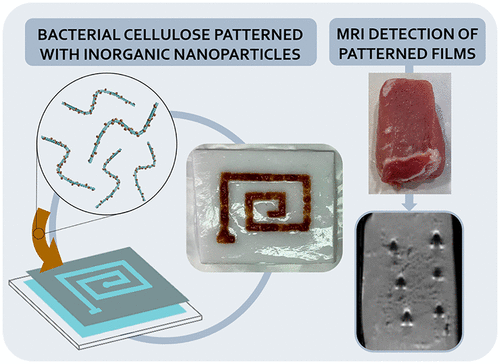当前位置:
X-MOL 学术
›
ACS Appl. Polym. Mater.
›
论文详情
Our official English website, www.x-mol.net, welcomes your
feedback! (Note: you will need to create a separate account there.)
Patterning Bacterial Cellulose Films with Iron Oxide Nanoparticles and Magnetic Resonance Imaging Monitoring
ACS Applied Polymer Materials ( IF 4.4 ) Pub Date : 2021-09-21 , DOI: 10.1021/acsapm.1c00723 Cristina Mira-Cuenca 1 , Thomas Meslier 1 , Soledad Roig-Sanchez 1 , Anna Laromaine 1 , Anna Roig 1
ACS Applied Polymer Materials ( IF 4.4 ) Pub Date : 2021-09-21 , DOI: 10.1021/acsapm.1c00723 Cristina Mira-Cuenca 1 , Thomas Meslier 1 , Soledad Roig-Sanchez 1 , Anna Laromaine 1 , Anna Roig 1
Affiliation

|
Biomaterials derived from nature can offer sustainable, biomimetic, and biointeractive solutions. Bacterial cellulose (BC) is a natural biopolymer gaining popularity in the medical field due to its biocompatibility, excellent mechanical properties, and animal-free origin. Those attributes, together with its optimal conformability to different surfaces and high water holding capacity, have endorsed the use of BC films in wound healing, tissue engineering, implants, or wearable sensors. The functionalization of the BC films with nanoparticles (NPs) and the spatial control of their disposition in a BC substrate could further boost BC opportunities in those sectors. Here we report on an original method to deposit superparamagnetic iron oxide NPs (SPIONs) in selected areas of a flat BC film (thickness 6 ± 1 μm, roughness 26 ± 3 nm) using a screen-printing process to create ad hoc NPs patterns on the film surface. The ink used for screen-printing consisted of a dense solution of blended BC fibers (BCf, length 14 ± 9 μm) previously coated with SPIONs using a microwave-assisted synthetic route. In addition, we have tested the easy identification of a BC/SPIONs implant inserted in a simulated tissue by magnetic resonance imaging (MRI) as provided by an ex vivo test. The SPIONs in the BC presented an excellent performance as a transverse relaxation (T2) contrast agent. Those functionalized BC films could enlarge their application as bioimplants and be noninvasively monitored for the detection of deformations and adhesions.
中文翻译:

用氧化铁纳米颗粒和磁共振成像监测图案化细菌纤维素膜
源自大自然的生物材料可以提供可持续、仿生和生物交互的解决方案。细菌纤维素 (BC) 是一种天然生物聚合物,由于其生物相容性、优异的机械性能和非动物来源,在医学领域越来越受欢迎。这些特性,连同其对不同表面的最佳顺应性和高保水能力,已经支持 BC 薄膜在伤口愈合、组织工程、植入物或可穿戴传感器中的使用。具有纳米颗粒 (NPs) 的 BC 膜的功能化以及它们在 BC 基板中的布置的空间控制可以进一步促进这些领域的 BC 机会。在这里,我们报告了一种在平面 BC 膜(厚度 6 ± 1 μm,薄膜表面上的特设NPs 图案。用于丝网印刷的油墨由混合 BC 纤维(BCf,长度 14 ± 9 μm)的致密溶液组成,之前使用微波辅助合成路线涂有 SPION。此外,我们还测试了通过离体测试提供的磁共振成像 (MRI) 轻松识别插入模拟组织中的 BC/SPIONs 植入物。BC 中的 SPION 作为横向弛豫 (T 2 ) 造影剂表现出优异的性能。这些功能化的 BC 膜可以扩大其作为生物植入物的应用,并可以无创地监测变形和粘连。
更新日期:2021-10-08
中文翻译:

用氧化铁纳米颗粒和磁共振成像监测图案化细菌纤维素膜
源自大自然的生物材料可以提供可持续、仿生和生物交互的解决方案。细菌纤维素 (BC) 是一种天然生物聚合物,由于其生物相容性、优异的机械性能和非动物来源,在医学领域越来越受欢迎。这些特性,连同其对不同表面的最佳顺应性和高保水能力,已经支持 BC 薄膜在伤口愈合、组织工程、植入物或可穿戴传感器中的使用。具有纳米颗粒 (NPs) 的 BC 膜的功能化以及它们在 BC 基板中的布置的空间控制可以进一步促进这些领域的 BC 机会。在这里,我们报告了一种在平面 BC 膜(厚度 6 ± 1 μm,薄膜表面上的特设NPs 图案。用于丝网印刷的油墨由混合 BC 纤维(BCf,长度 14 ± 9 μm)的致密溶液组成,之前使用微波辅助合成路线涂有 SPION。此外,我们还测试了通过离体测试提供的磁共振成像 (MRI) 轻松识别插入模拟组织中的 BC/SPIONs 植入物。BC 中的 SPION 作为横向弛豫 (T 2 ) 造影剂表现出优异的性能。这些功能化的 BC 膜可以扩大其作为生物植入物的应用,并可以无创地监测变形和粘连。











































 京公网安备 11010802027423号
京公网安备 11010802027423号